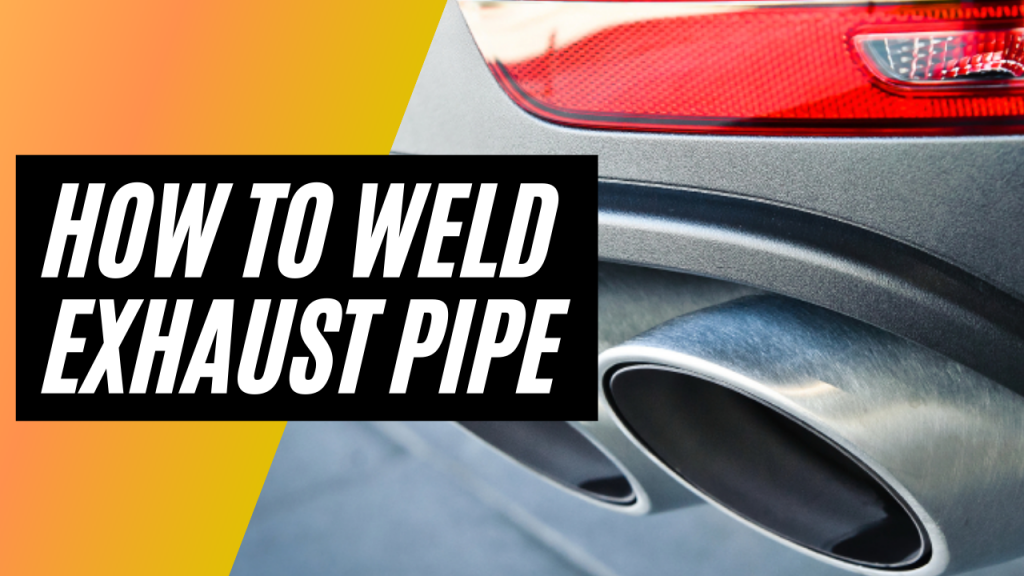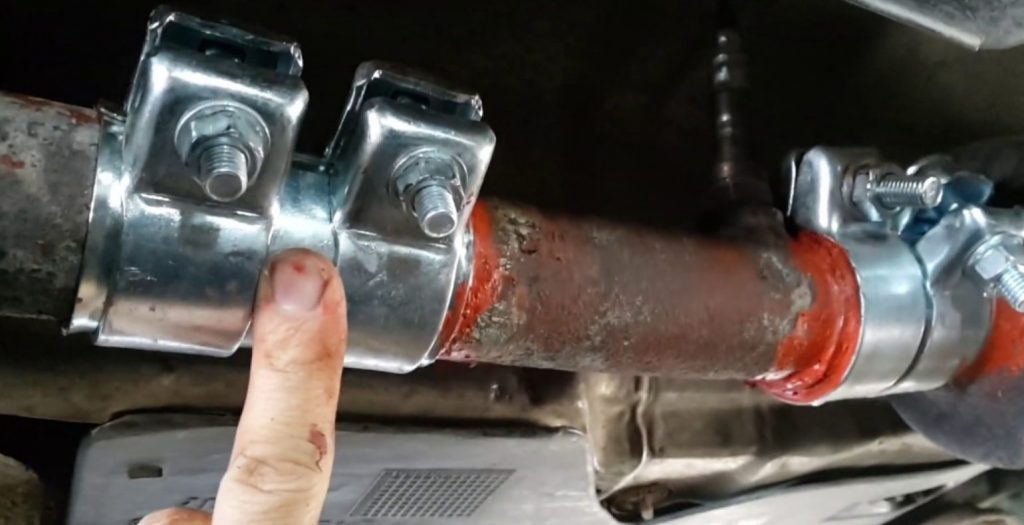It is typical for an automobile’s exhaust pipe to require minor repairs after a time. Currently, there’s no need to visit the garage to weld the pipe. Welding exhaust tube could be done at home with very little advice and help keep some money to spare instead of paying professionals.
It may be done fast with any welder, tig, mig, or stick, and it is not too complex to do on your own. It merely requires some schooling and attention. These pipes are thinner than many others; they are as mild as 0.028. Therefore it requires more care while welding exhaust pipes.
Follow the following measures by measure, a manual to recreate an exhaust pipe. With this simple welding understanding, you do not have to have a professional degree.

10 Scenarios
Considered
110 Hours of Research
15 Experts Interviewed
300 Reviews Analyzed
The Four Main Steps Associated with Welding
The best way to successfully weld an exhaust pipe is to have several repair tools at your disposal. Of course, the first thing on the list should be a functional welder. Also, you will need a hacksaw, a grinder, a circular chain saw, as well as a welding mask to do this job.
When welding exhaust tubes, you should follow the following steps:
Cut the Pipe
Despite what it might seem, this process isn’t as simple as it appears. Mufflers must be cut with precision, as your cutting technique will determine how the exhaust pipe looks in the end. Pipes are marked out and the cutting areas are identified.
Make sure the exhaust tubing is cut as neatly as possible using a hacksaw or chain pipe cutter. Professionalism and aesthetics are enhanced by cutting straight. As soon as you are done, you can use a grinder to smooth out the edges and remove any imperfections.
Besides exposing the base metal, grinding also removes dirt, rust, or paint that may be present on the surface. As a result, you will be able to weld with no impurities.
Clamp the Pieces
Once the tubing pieces have been thoroughly cleaned and prepared for use, the next step is to clamp them together as a final step. To make this process as easy as possible, you will need C-clamps. To weld the tubing (two-piece) together, these clamps are going to be used to hold it together while you are welding it. The tubing must be fitted according to your preferred style when using a c-clamp, as these adjustments need to be taken into account when using a c-clamp.
Spot Welding
As exhaust tubing is usually thin, spot welding should be used (doing three to five tiny welds around the tube) because exhaust tubes are usually thin. It’s important not to worry, however, because the high temperatures produced when welding will prevent any warping from occurring.
Because the spot welds are the ones that play the important role in securing the tube in place, it is easy to bend gaps into place if they occur on the opposite side of the tube.
Complete the Weld
Weld the gaps remaining in the tubing after spot welding has been carried out to complete the process. Whenever possible, it is essential to weld all around the tubing’s circumference to ensure that leaks are not likely to occur. It is advisable to weld over the spot welds if you want a durable and sturdy weld.
How to Weld Exhaust Pipe?

1- Use Stick Welding to Weld Exhaust Pipe
Many people assert that stick welding isn’t the ideal one for your exhaust tube repair, but it will entertain you to attain excellent results by learning how to work with a stick welder successfully. Get prepared to think beyond the box while beginning repairs the muffler with rod welding.
Although welding is remarkably influenced by paint, rust, or dirt, we still advocate cleaning the cover to prevent slag.
The first and foremost step is to realize the ideal rod to utilize. We are going to recommend using 6011 sticks for their accurate welds on thin surfaces. Moreover, make sure to use the 6011 sticks to your thinnest weld to acquire hands-free. The 6011 pole helps for spot welding before welding across the muffler’s border.
Pros of using Stick Welding to Fix your Exhaust Pipe
- You can stick weld anywhere whether outdoors or inside the workshop
- Stick welding is possible in all weather conditions
- Stick welding is not sensitive to paint, dirt and rust compared to other welding techniques
- Stick welding equipment is fairly easy to use and inexpensive
Cons of Stick Welding
- If not done well, stick welding can lead to the production of slag which can lead to leaks
- You will use several electrodes
Tips of utilizing Stick Welding to Weld the Exhaust Pipe

- Can adhere weld everywhere
- Potential to use in most weather conditions
- Stick welding equipment is inexpensive and Simple to Use..
- When the rod welding is not done well, it May Lead to escapes.
- Yit Should utilize several terminals.
2- Utilizing MIG Welding to weld Exhaust Pipe
Compared to flix heart and stick welding, the MIG welding is significantly more satisfactory to weld exhaust pipes. It allows performing a fantastic job with MIG welding to repair the muffler. To begin welding exhaust pipes, the first thing to do would be to wash out the base metal to prepare it thoroughly.
A metallic brush is your ideal choice to wash out the muffler’s tubing and helpful since it exposes the base alloy. Make sure the tubing is free of any rust and dust. We advocate using a blend of argon and carbon dioxide to weld the exhaust tube using MIG welding.
To prevent flashing over the exhaust, it is perfect to use a mean amp range to protect against burning off the thin surface.
Tips of utilizing Mig Welding to Weld the Exhaust Pipe
- You do not need to Be Concerned about slag.
- There will be no regular during the welding job.
- MIG welding may be done by using semi and full Practices..
- It is a precise and quicker welding technique.
- It may additionally use on metals due to its flexibility.
- It requires an external shielding gas container..
- It cannot be Utilized in windy conditions or outdoors..
3- Flux Core Welding to weld Exhaust Pipe
As professionals don’t highly suggest flux core welding to repair an exhaust tube, it may be used to your DIY fix the muffler. Before using flux core welding, make sure to wash out the tube to lower the spatter.
The wire feed rate also has to fix to make it briefer grains and preventing burn throughout the tube as a scorching arc impact. Be ready to place the amperage range when diminishing the AMP to get flux-core welding may supply thicker arcs.
Pros of Welding your Exhaust Pipe using Flux-Core Welding
- Can be done without the need of a gas shielding tank
- Provides better penetration compared to MIG electrodes
- Cost is less than that of using MIG wires
- The cost of equipment is far less compared to MIG and TIG welding
- The wire is continuously fed thus removing the need of changing the electrode continuously
Disadvantages of Welding the Exhaust using Flux-Core
- Can easily burn through thin metals, thus needing a high level of precision
- Flux-core welding will produce more spatter.
Tips of utilizing Flux Core Welding to Weld the Exhaust Pipe
- No need to utilize a gas protecting tank..
- Create better penetration instead of MIG electrodes..
- The equipment cost is less than Tig and Mig Welding…
- Not pricey as much that the MIG wire is..
- The cables are always maintained to eliminate the requirement to control the electrode continuously..
- It requires an external shielding gas container..
- Desire a high level of precision..
4- Welding Exhaust Tube by Utilizing TIG Welding
Tig welding is the greatest and specially constructed for welding thin metallic sheets precisely like the tube. This technique may utilize to weld exhaust tubes created from thin allot, for example, stainless steel.
Nonetheless, it requires some precaution while using tig welding.
The foundation surface could be sterile and free of rust, oil, soil, and paint. The first task would be to clean out the pipe and be sure that there is no debris left. Has acetone raced lag, which will help to eliminate oil? The petroleum may stay as debris originating out of the heavy lube oils employed to mufflers.
Even when the filler rod is the smallest during tig welding, then utilize a 3/32 inch pole since it’s the perfect tungsten rod. The mind output ought to be accurate since it’s a thin tube.
Using a foot lever may support adjusting the general temperature output that is based upon the alloy thickness. Since the tig welding is ideal for narrow surfaces and alloys, we will advocate using it to weld an exhaust pipe.
Advantages of Welding your Exhaust Pipe Using TIG
- The most ideal welding technique for thin metal sheets like exhaust tubing is TIG welding
- The resulting weld in usually clean, neat, free from slag and aesthetically appealing
- TIG welding produces less heat when compared to other welding techniques, making it ideal for thin metals
- TIG welding is ideal for welding a wide range of thin metal and alloys
Cons of Welding Exhaust Pipes using TIG
- Takes time to set up by cleaning and compared to other techniques
Tips of utilizing TIG Welding to Weld the Exhaust Pipe
- Perfect welding technology for thin metals…
- Keep them clean, clean, aesthetic, and free of scum…
- Generates less heat than solder flux bars and cores…
- Ideal for welding a wide variety of alloys and thin metals…
- It takes some time to set it up because it requires more cleaning than other techniques…
Conclusion
Exhaust pipes are usually made of soft metal. Some are even made of alloys, which makes them very sensitive to heat. To prevent welds from penetrating the base metal, it is best to choose the correct welding technique.
We recommend TIG welding to be ideal for smooth and susceptible metal surfaces and best for exhaust pipes. You can also use MIG welding if you don’t have the necessary tools to do TIG welding.